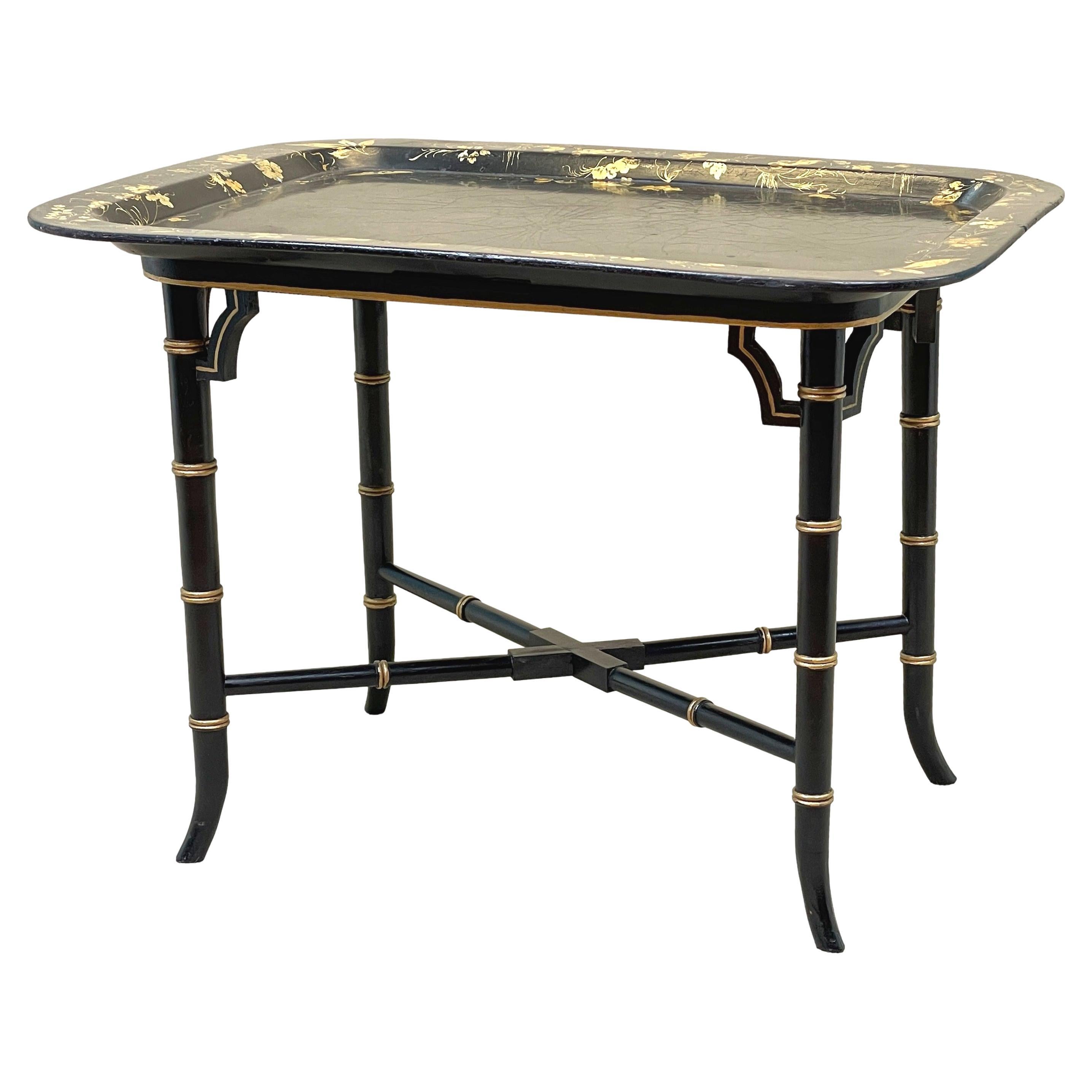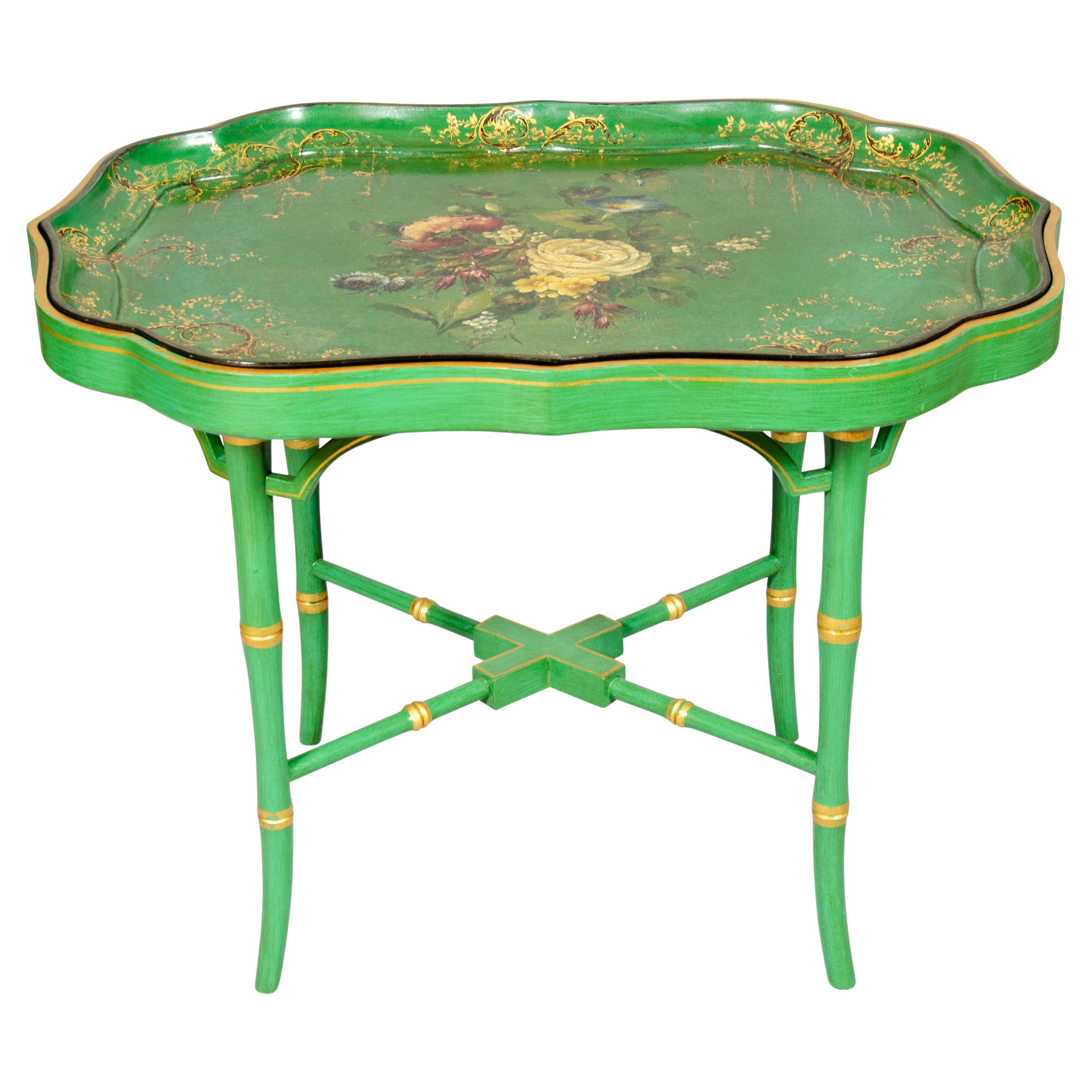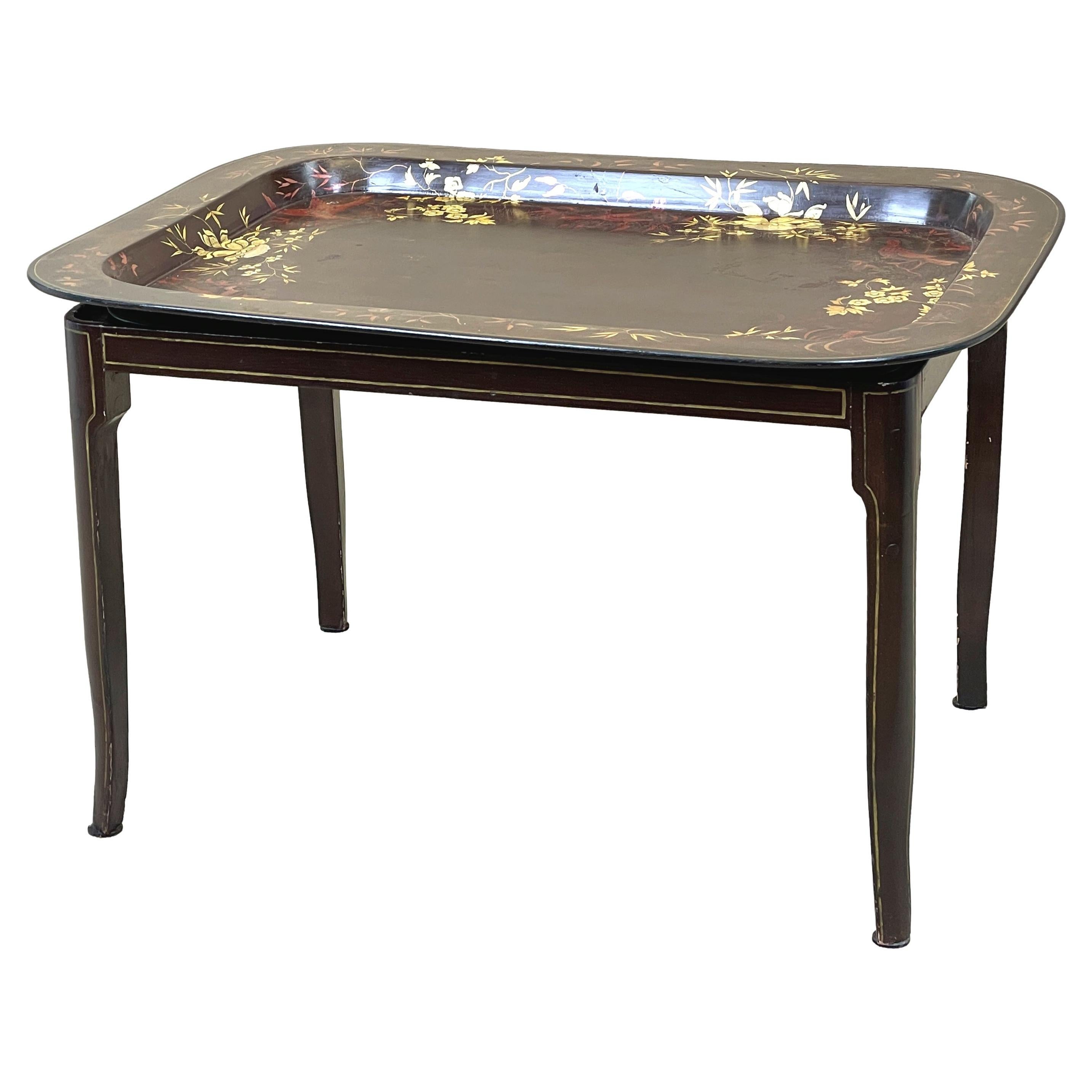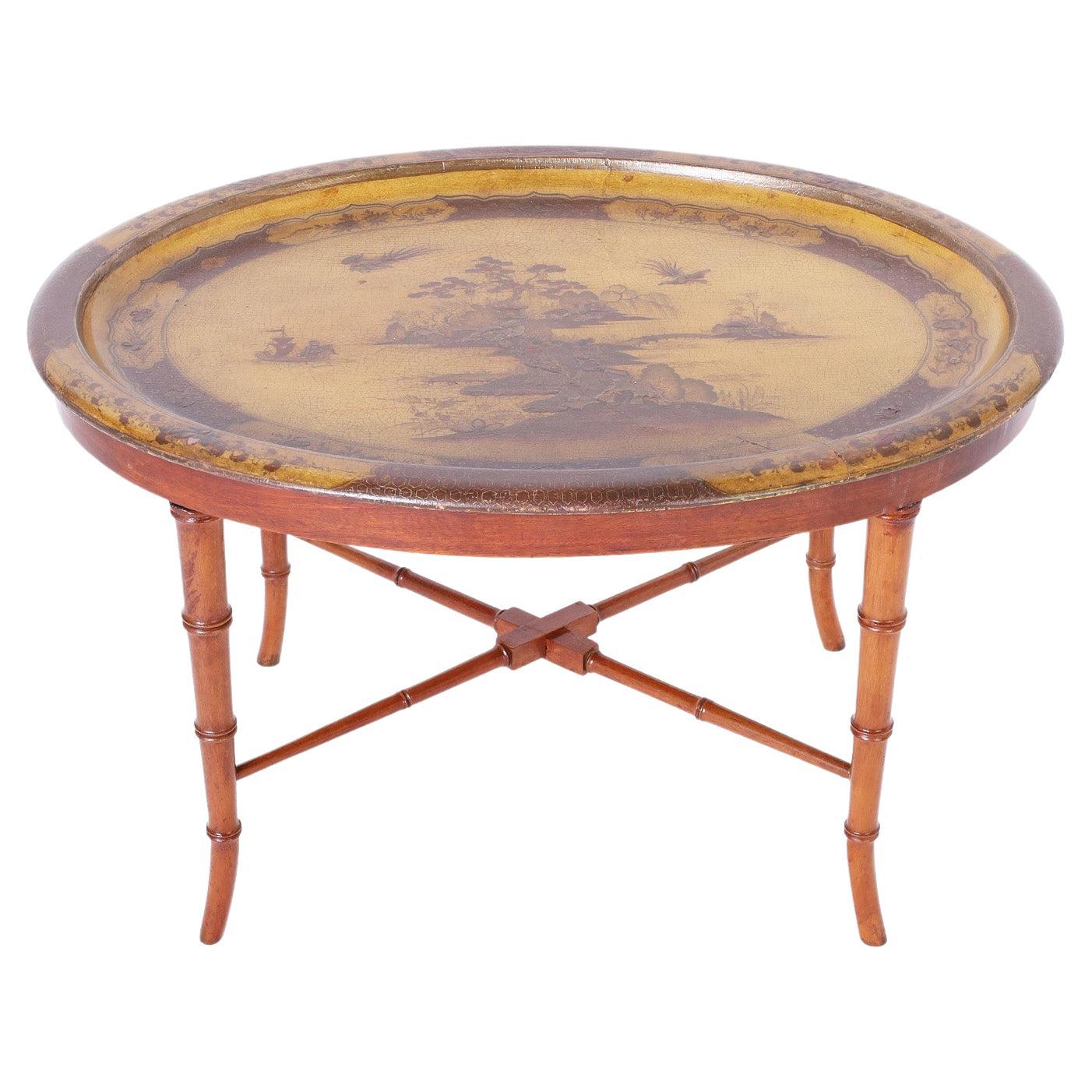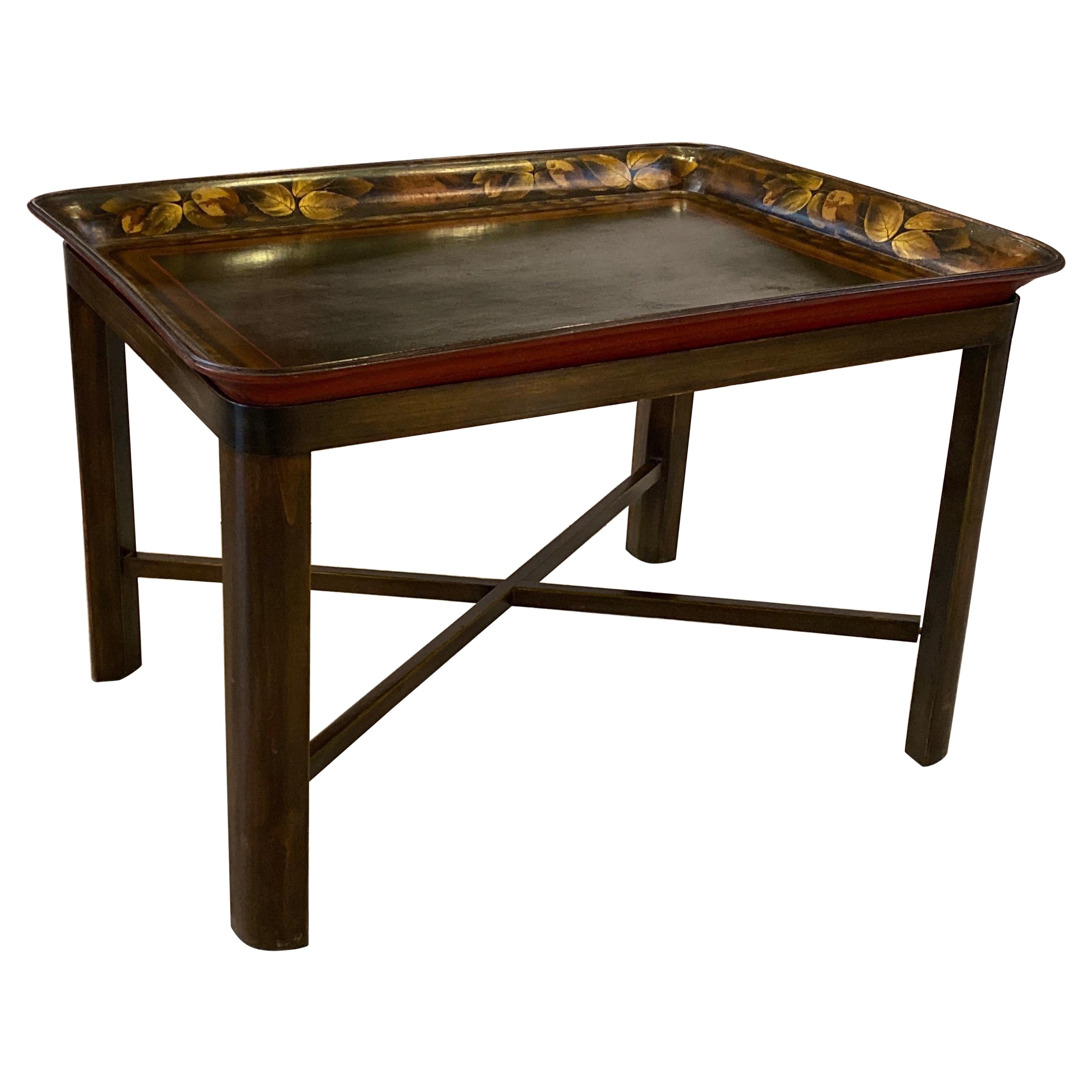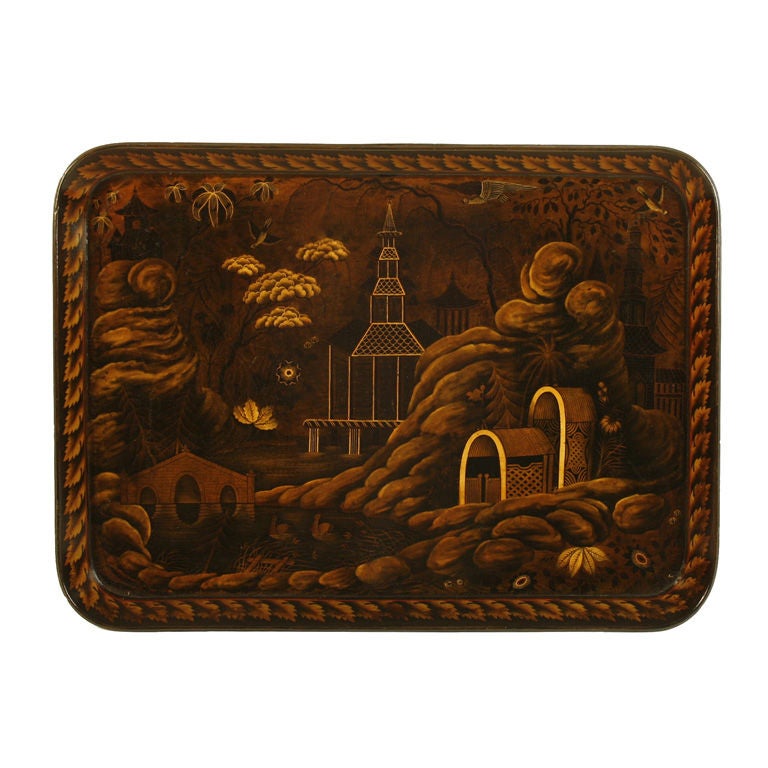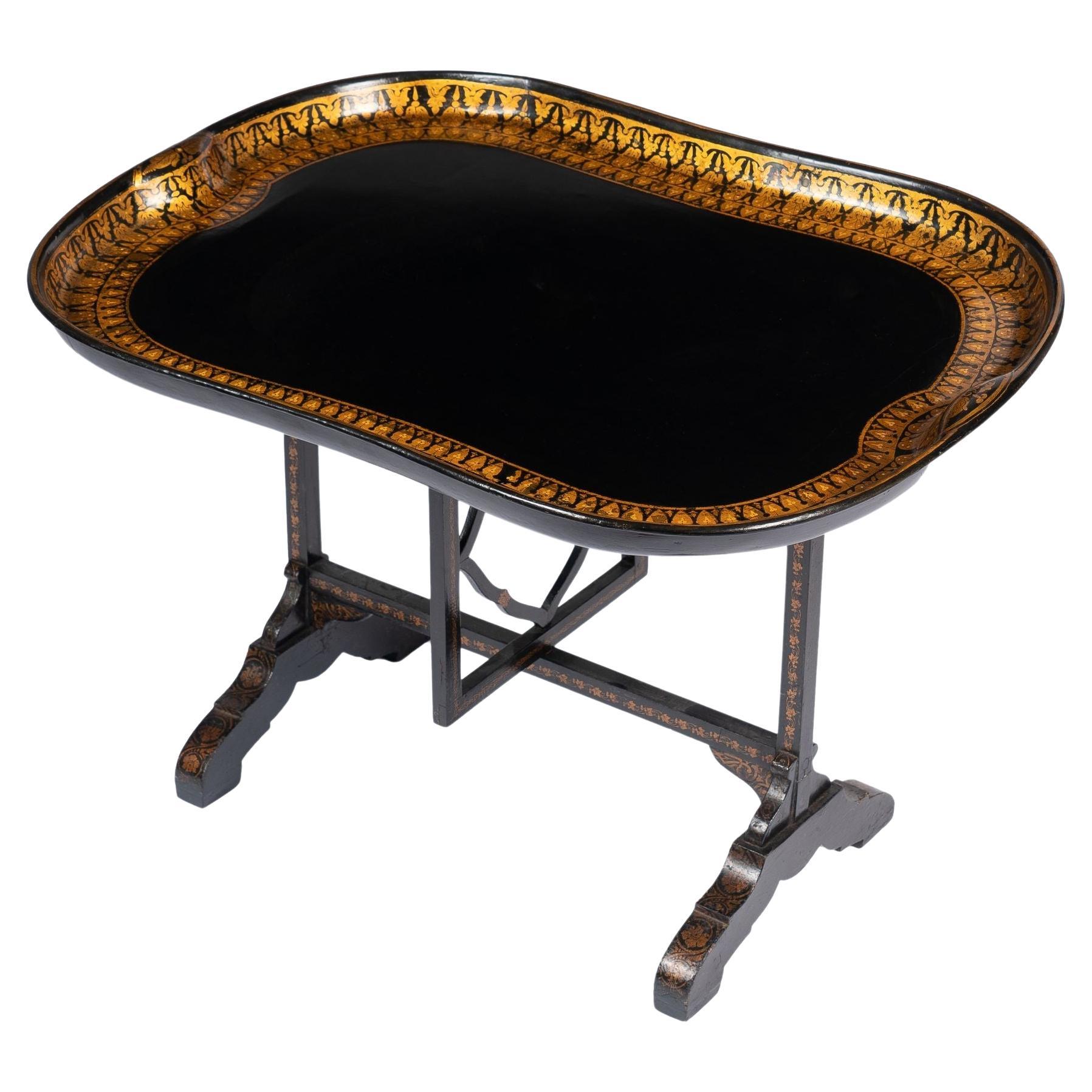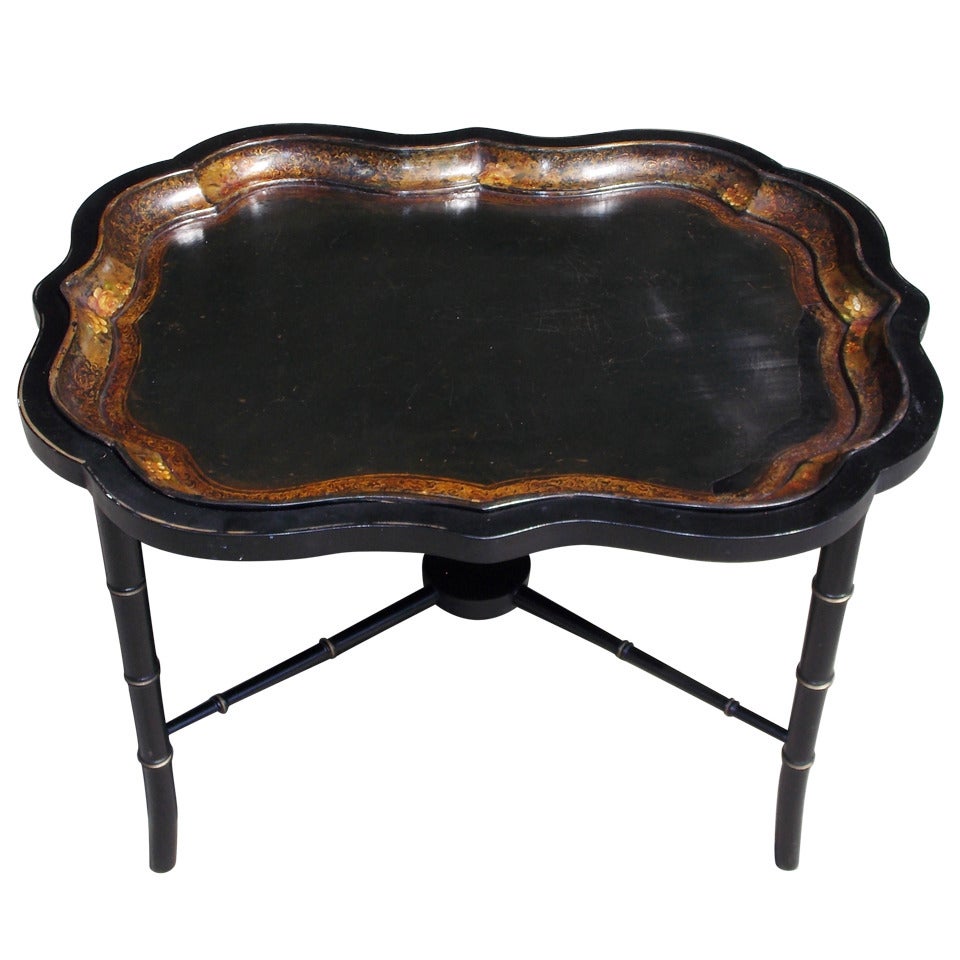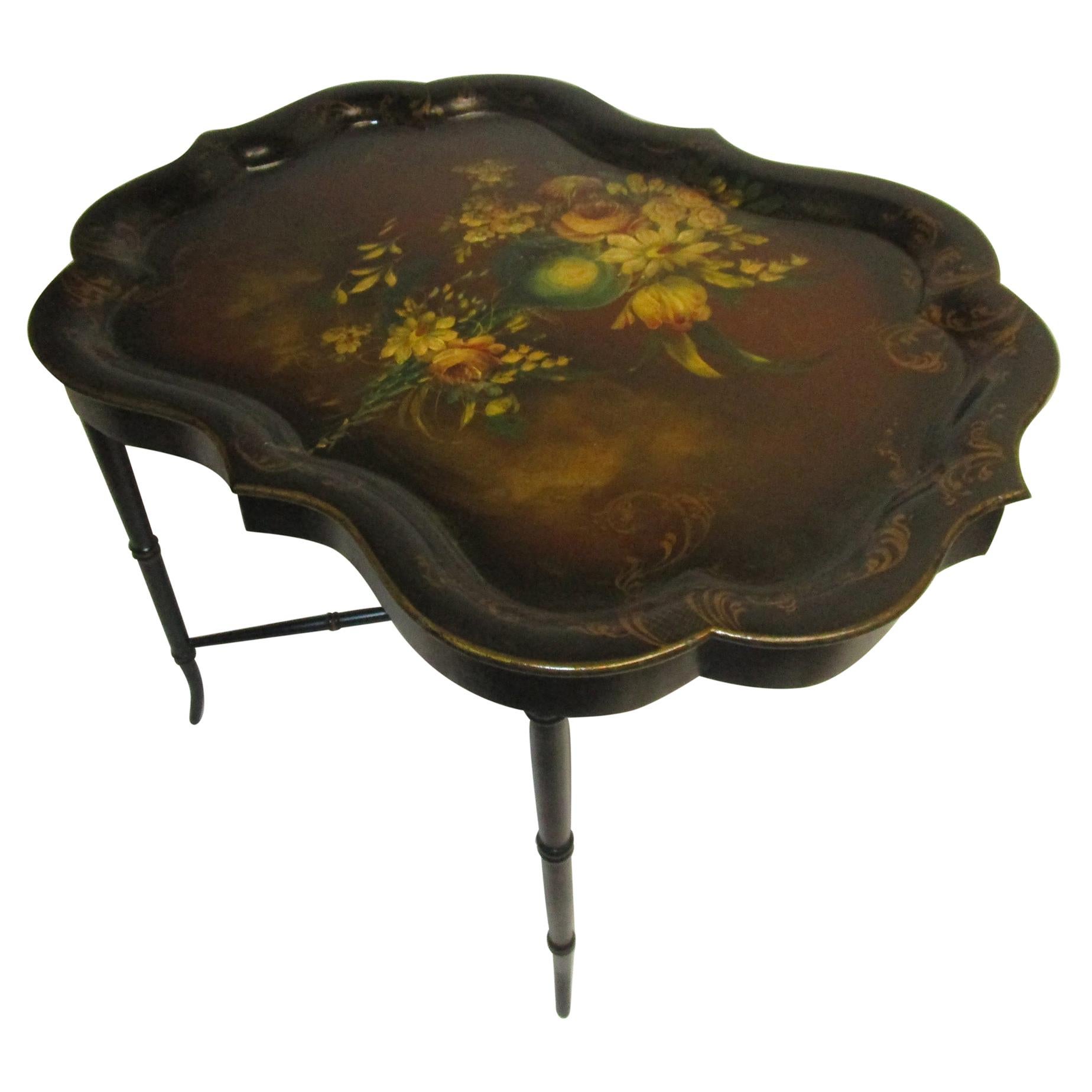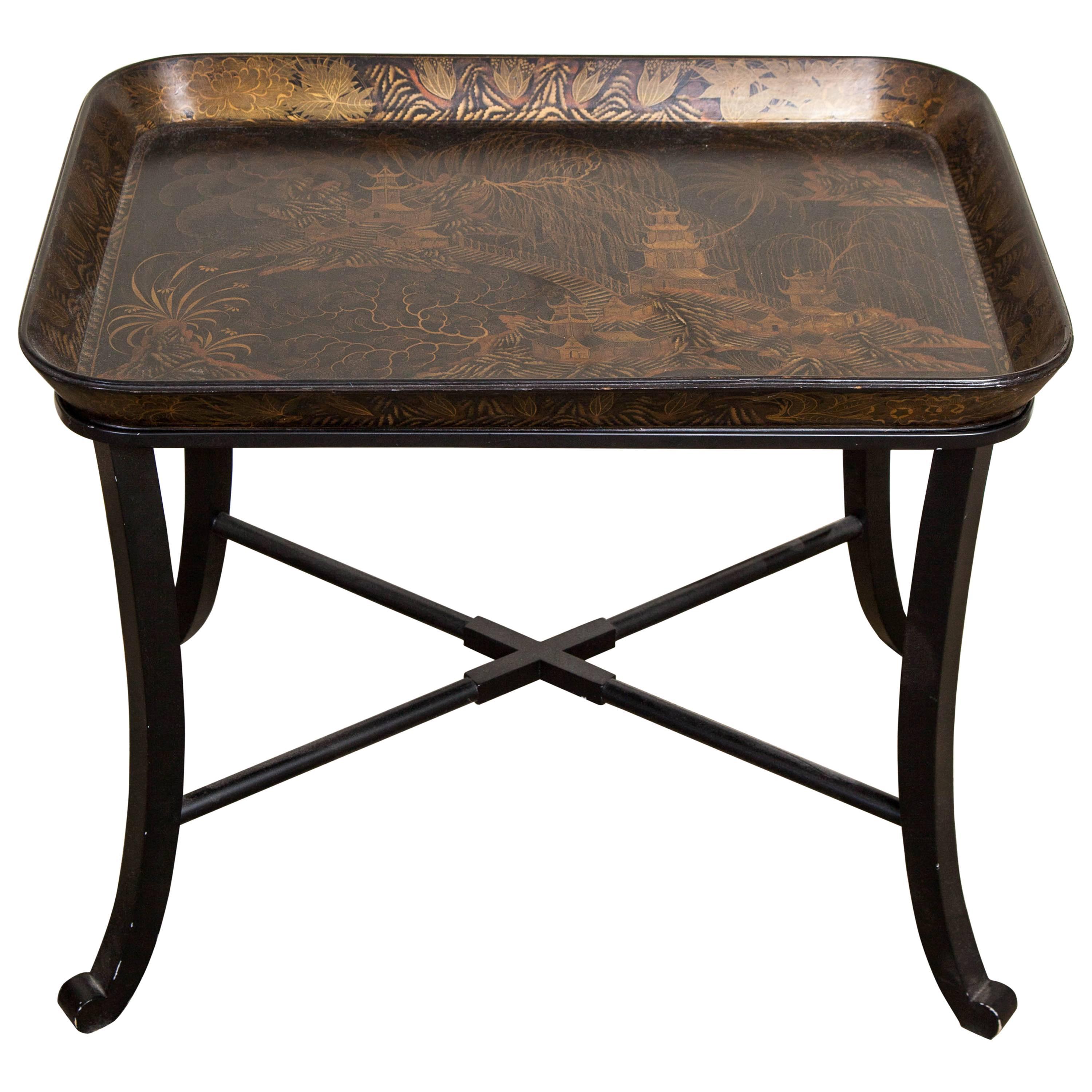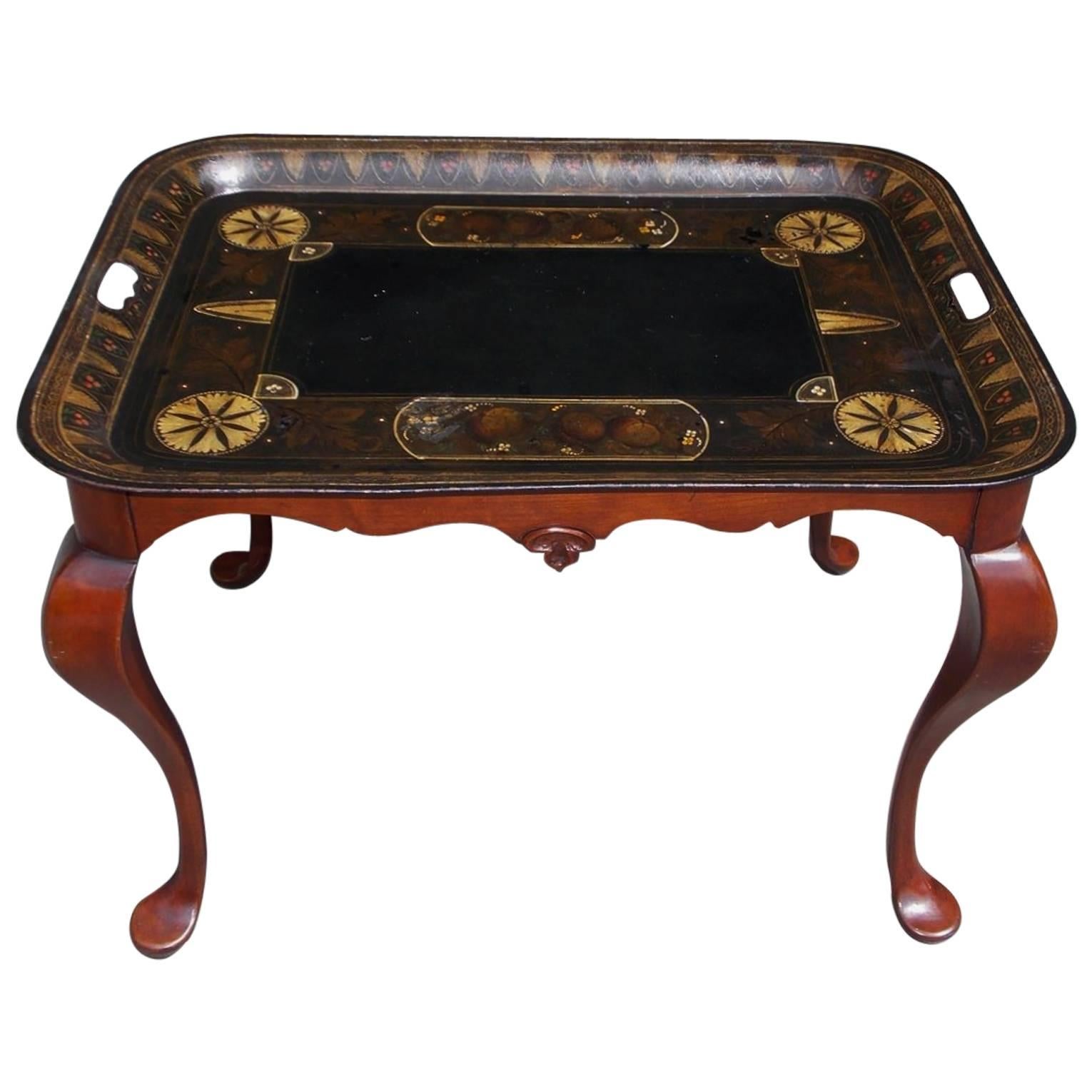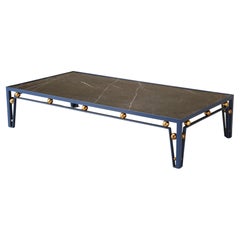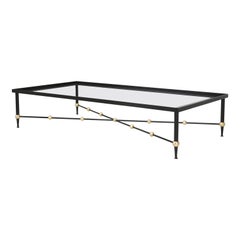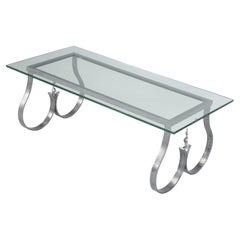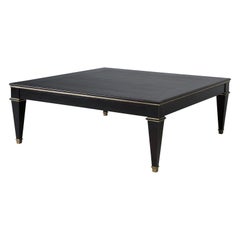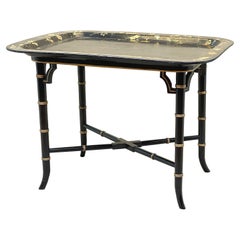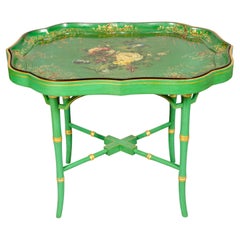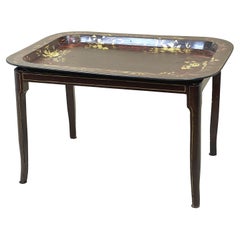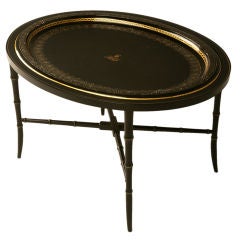
c.1830 Jennens & Bettridge M.O.P. Papier Mache Tray on Stand
View Similar Items
Want more images or videos?
Request additional images or videos from the seller
1 of 11
c.1830 Jennens & Bettridge M.O.P. Papier Mache Tray on Stand
About the Item
PAPIER MACHE HAS AN EXCITING AND ANCIENT HISTORY, ORIGINATING IN CHINA IN THE EARLY YEARS OF THE 2ND CENTURY AD. IT HAS BEEN USED SINCE TO MAKE CHAIRS FOR ROYALTY, PANELS FOR COACHES, JEWELLERY, AND EVEN CHINESE SPEARS AND ARMOUR.
Paper was first made by Ts' ai Lun, an official at the Chinese court of the Emperor Ho Ti, who developed an ingenious way of breaking down plants and rags into single fibres. The fibres were pounded to a pulp and collected on a fabric-covered frame, where they matted and dried as paper. The knowledge of paper-making spread to Japan, the Middle East and India, finally reaching Europe via Spain in the 10th century AD.
The modern-day practice of recycling waste paper into moulded objects became well established in Persia and India, where craftsmen made extravagantly lacquered and embellished papier mache pen holders from around the 15th century. Kashmir in Northern India was an important center of this art; its products were exported to Europe during the 16th and 17th centuries as trade routes developed, and were much admired for the quality of their lacquering and their exquisitely painted decoration. A flourishing trade in eastern goods developed, as a mania for chinoiserie objects with Oriental motifs executed in a Western style - gripped Europe. Demand far exceeded supply, and workshops were set up, notably in France and England, to produce home-grown imitations of items such as porcelain and lacquerware. French craftsmen were intrigued by Oriental papier mache and experimented with the medium, adding materials such as sand, glue and chalk to the pulped paper. They developed their techniques until capable of producing convincing moulded architectural ornaments in imitation of costly stucco and plasterwork. This practice was also adopted in England, where several papier mache workshops were established, primarily in London and the Midlands. The development of a lacquering process that compared favorably with Japanese and Chinese lacquerware also helped to establish papier mache in Europe. Known as japanning, this quicker, less expensive technique was used widely from the 1740s in the decoration of papier mache items such as small tables, snuff boxes and hand mirrors. In the mid 18th century Henry Clay, assistant to John Baskerville, a manufacturer from Birmingham, England, took a step forward in papier mache production, which laid the foundations of a whole industry. Clay's innovation was to produce laminated panels, made from pasted paper sheets rather than pulped paper. The panels were sealed with linseed oil and dried slowly under a low heat, which made them extremely strong. They were used for everyday articles, such as furniture, and the material was ideally suited to japanning (varnishing) and painting. Clay's panels were so strong and resilient that they were also used to make the walls of horse-drawn coaches. Clay patented his invention in 1772, and by the time the patents expired in 1802, he was very wealthy. His Birmingham factory was taken over in 1816 by what was to become the most famous partnership in the papier mache industry, Jennens and Bettridge.
Jennens and Bettridge raised papier mache design to new heights, introducing all kinds of decorative and practical refinements. They developed a distinctive range of japanned goods inlaid with slivers of mother-of-pearl; later they included tortoiseshell, ivory and precious stones. They also patented a method of steam-moulding and pressing papier mache panels into large-scale architectural features, such as internal walls for steamships. By ]850, Jennens and Bettridge were England's foremost exponents of papier mache. They had a huge workforce, with ex-employees leaving to set up their own factories. At London's Great Exhibition of 1851 in the Crystal Palace, papier mache was hailed as an important material with a bright future, and Jennens and Bettridge exhibited a wide range of artifacts, including a child's cot, a chair and a piano. This was the heyday of papier mache production in Europe. Manufacturing methods had become extremely sophisticated, and the resulting objects were indistinguishable from the finest lacquered wood. A huge range of items, from buttons to headboards, was produced; George Jackson and Son made stunningly ornate imitation plaster- and stucco-work ceilings and walls, and Charles Bielcfield produced a papier mache "village" of eleven houses for export to Australia. Papier mache was also popular in North America, and Jennens and Bettridge, and other manufacturers, were exporting their wares there before the middle of the 19th century.
In 1850, when the United States' first papier mache factory was established at Litchfield, Connecticut, English workers were brought over to teach their skills. The Litchfield Manufacturing Company was started by English-born Quaker William Allgood, and was successful from the start. The factory initially produced small ornamental items, such as fans and card cases, but then concentrated on making papier mache versions of the area's main product, decorative clock cases. These were warmly received, and commended at the World Fair in New York in 1854. Litchfield Manufacturing merged with a clock company in 1855, but a nearby factory, Wadhams Manufacturing Co. continued to produce papier mache such as desks and game boards, until the outbreak of the American Civil War. Although the western papier mache industries had run out of steam by the end of the 19th century, cultures who had been consistently using papier mache continued making boxes, cases, lamp-stands, trays and frames, decorated with extremely intricate traditional designs, such as interlocking flowers, animals and scenes from court life. The tourist economies of Kashmir and Rajasthan benefit to this day. In Mexico, remarkable papier mache sculptures and artifacts are made throughout the year to commemorate religious festivals. The best known of these is on All Souls' Day, known as the Day of the Dead, when Mexicans build ornate shrines and prepare meals for departed relatives whom they believe will come to visit. Brightly colored skeletons going about everyday activities, devils, skulls, angels and various other characters can be seen, all made from papier mache. Many of the sculptors are anonymous, but a few are well known. The late Pedro Linares, for example, was the head of a papier mache making family, whose highly original work was collected by admirers including the painters Diego Rivera and Frida Kahlo. His family continues in this tradition, making amazing constructions, many hand-modelled without using moulds, of intricate figures of the dead or of symbolic animals, such as dragons or roosters. Spain is another contemporary stronghold of papier mache production, where enormous papier mache characters with huge heads join the religious processions at Corpus Christi, and are later blown up with fireworks.
The craft of papier mache has recently undergone a huge revival of interest in Europe and America. This could be because of the current interest in recycling waste paper, the relative low cost and availability of the material, the ease with which the basic skills can be learned, or simply an appreciation of the vitality, versatility and beauty of the medium. Whatever the reason, this simple material - paper - has inspired ancient and contemporary designers to produce exciting and original work and it looks set to continue well into the 21st century.
- Dimensions:Height: 18.75 in (47.63 cm)Width: 33.25 in (84.46 cm)Depth: 25.5 in (64.77 cm)
- Materials and Techniques:
- Place of Origin:
- Period:
- Date of Manufacture:circa 1830's
- Condition:In very nice original condition.
- Seller Location:Chicago, IL
- Reference Number:Seller: da11stDibs: U10021982432626
About the Seller
4.8
Platinum Seller
Premium sellers with a 4.7+ rating and 24-hour response times
Established in 1992
1stDibs seller since 2006
1,457 sales on 1stDibs
Authenticity Guarantee
In the unlikely event there’s an issue with an item’s authenticity, contact us within 1 year for a full refund. DetailsMoney-Back Guarantee
If your item is not as described, is damaged in transit, or does not arrive, contact us within 7 days for a full refund. Details24-Hour Cancellation
You have a 24-hour grace period in which to reconsider your purchase, with no questions asked.Vetted Professional Sellers
Our world-class sellers must adhere to strict standards for service and quality, maintaining the integrity of our listings.Price-Match Guarantee
If you find that a seller listed the same item for a lower price elsewhere, we’ll match it.Trusted Global Delivery
Our best-in-class carrier network provides specialized shipping options worldwide, including custom delivery.More From This Seller
View AllMid-Century Modern Coffee Table Inspired by Jean Royere Made to Order Old Plank
By Jean Royère
Located in Chicago, IL
Mid-Century Modern Coffee Table Inspired by Jean Royere and Made to Order in Chicago by Old Plank. Our Mid-Century Modern Steel, Brass and Marble Coffee Table can be built in most an...
Category
2010s American Mid-Century Modern Coffee and Cocktail Tables
Materials
Marble, Metal, Brass, Steel
René Prou Inspired Handmade Mid-Century Style Coffee Table in Any Size, Finish
Located in Chicago, IL
René Prou 1889–1947 Inspired Custom Hand-Made Steel Coffee Table with Gilded Spheres made to order by Old Plank in Chicago and available in virtually any dimension or finish. Rene Pr...
Category
2010s American Mid-Century Modern Coffee and Cocktail Tables
Materials
Brass, Steel
Burnished Steel and Glass Coffee Table from the 1960's
Located in Chicago, IL
Steel and Glass Coffee Table that originally arrived to us with black paint and as we removed the poorly applied black finish, we started to notice how nice the steel was. Well, afte...
Category
Vintage 1960s French Industrial Coffee and Cocktail Tables
Materials
Steel
French Maison Jansen Style Ebonized Mahogany Coffee Table Built to Order
Located in Chicago, IL
French Maison Jansen or Directoire style coffee table that in our home, might more accurately be described as a cocktail table. This particular Maison Jansen or Directoire style coff...
Category
2010s American Directoire Coffee and Cocktail Tables
Materials
Mahogany
French Louis XVI Solid Bronze Coffee Table Custom Made to Order in Any Size
Located in Chicago, IL
French Louis XVI Inspired Solid Bronze Coffee Table by Old Plank. The legs on this solid bronze coffee table are exact copies of the legs on a vintage French 1940s Louis XVI Style Co...
Category
2010s American Louis XVI Coffee and Cocktail Tables
Materials
Bronze
French Louis XVI Bronze Square Coffee Table Custom Hand-Made in Chicago Any Size
Located in Chicago, IL
French Louis XVI Solid Bronze Coffee Table with Fluted French Louis XVI Legs. We copied the Louis XVI legs from a vintage French Coffee Table that we purchased in France many years a...
Category
2010s American Louis XVI Coffee and Cocktail Tables
Materials
Bronze
You May Also Like
Regency Papier Mache Tray On Stand
Located in Bedfordshire, GB
A Good Quality Regency Period Oblong Papier Mache Tray With Very Attractive Hand Painted And Gilded Decoration Raised On Elegant Later Faux Bamboo Design Stand.
What better way t...
Category
Antique Mid-19th Century English Regency Coffee and Cocktail Tables
Materials
Paper
Victorian Papier Maché Tray on Stand
Located in Montreal, QC
Victorian rectangular papier-mâché tray, on later stand.
This is an outstanding example, which got our attention by its many unusual qualities. It is large, with a dished rim, gilt ...
Category
Antique 19th Century English Victorian Tray Tables
Materials
Tin
Victorian Apple Green Papier Mache Tray Table by Jennens & Bettridge's
Located in Essex, MA
Shaped tray with floral decoration and conforming separate base. Signed on underside of tray.
Category
Antique 1850s English Victorian Tray Tables
Materials
Paper
19th Century Papier Mache Tray on Stand
Located in Bedfordshire, GB
A very attractive mid 19th century oblong papier
maché tray having elegant hand painted and
gilded floral decoration housed on later
square tapered leg stand
(What better way t...
Category
Antique Mid-19th Century English Victorian Coffee and Cocktail Tables
Materials
Paper
Chinoiserie Papier-Mâché Tray and Faux Bamboo Stand
Located in Palm Beach, FL
19th century English serving tray crafted in papier-mâché and lacquer in classic form and hand decorated in scenes of chinoiserie wi...
Category
Antique Mid-19th Century English Chinoiserie Coffee and Cocktail Tables
Materials
Mahogany
Antique 19 Century English Papier-mâché Tray Table
Located in Lambertville, NJ
A circa 1870's Papier Mache had gilt and decorated tray with a later custom dark wood base. The tray table with the tray fitting into the custom base. Can be removed and used for ser...
Category
Antique 1870s English Regency Tray Tables
Materials
Hardwood
Recently Viewed
View AllMore Ways To Browse
Chinese Gaming Jewelry
18th Century Plant Stand
Vintage Premier Designs Jewelry
Precious Stones Horse
Antique Ceiling Paper
Rajasthan Jewelry
Antique Steamship
Horse Mother Of Pearl
Jackson Jewelry
15th C Table
Paste Stone Frame
Crystal Horse Head
Shriner Jewelry
Shriners Jewellery
Vintage China Buttons
Vintage Mexican Ornaments
Vintage Coach Jewelry
Vintage Step Up End Tables
